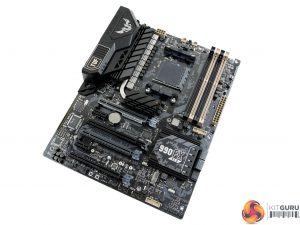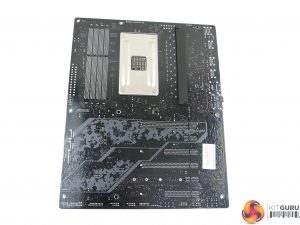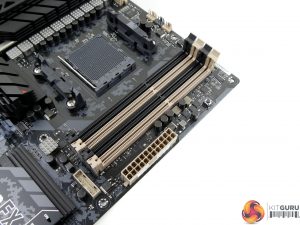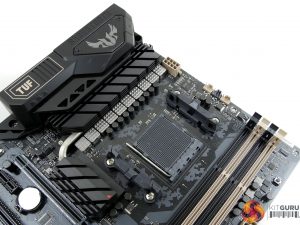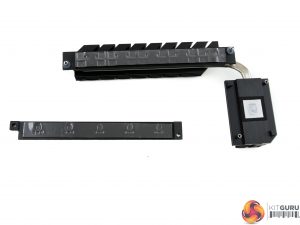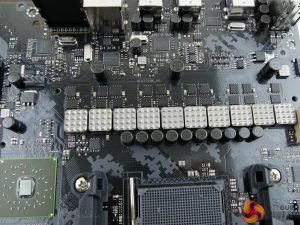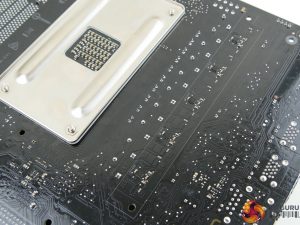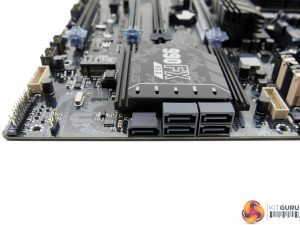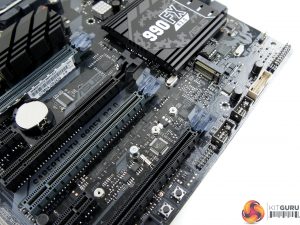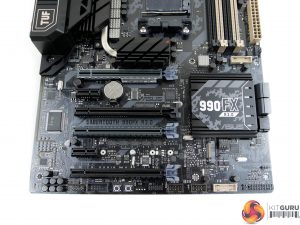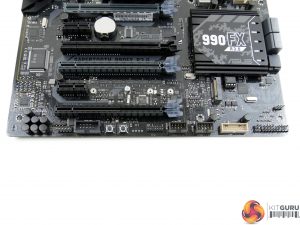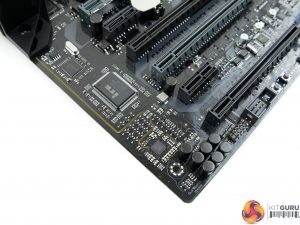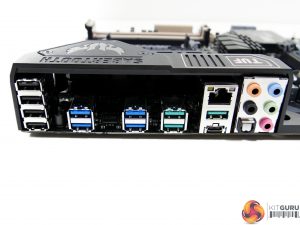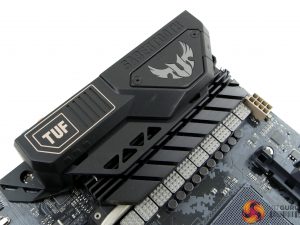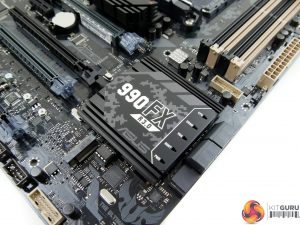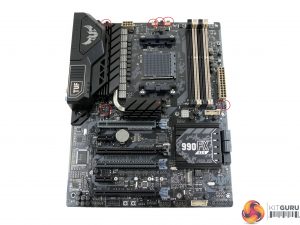Styling for the Sabertooth 990FX R3.0 is typical for a TUF Sabertooth board. The PCB features a camo black and grey styling with a reflective finish while hints of beige and white are sprinkled around the board adding to the military-style theme. RGB lighting, primarily found on the PCIe slot connectors, can be used to add customisable colours.
A rear IO cover serves two purposes – blocking out the ugly rear ports and acting as a mounting location for a small rear fan that can be used to cool the VRM components. A heatsink on the board’s rear side cools additional components relating to the power delivery system. A healthy quota of PCIe lanes from the 990FX Northbridge means that a pair of electrical x16 slots are wired alongside two x8 links (one of which is limited to x4 usage).
Up to 32GB of DDR3 memory can be installed in the four DIMM slots. ASUS quotes support for dual-channel DDR3 at up to 1866MHz frequency but we used 2400MHz RAM without problems thanks to the high divider in ASUS’ UEFI. A Digi+ ASP1103 chip manages power for the memory.
One of the board’s two 5Gbps USB 3.0 internal headers is found below the 24-pin connector. This location is fine but ASUS’ mounting point is slightly inwards of the board’s edge and the orientation is horizontal, making cable management a more challenging task.
An 8+2-phase power delivery system feeds the AM3+ CPU socket. With TDPs as high as 220W before overclocking, that 8+2-phase system will be put to suitable work when running a high-clocked 8-core Vishera chip.
The ‘TUF’ power delivery components are made up of ON Semiconductors 4C06B and 4C09B MOSFETs for the high and low side as well as 5000-hour-rated capacitors and alloy chokes. Managing the system is an ASUS-packaged Digi+ VRM EPU ASP1000C PWM controller which seems to provide 5 true phases for the CPU that are doubled to 10 physical phases using IRC S598 EXLRP doublers/drivers mounted on the rear. Cooling for the MOSFETs looks to be proficient and clock gen duties are handled by an ICS chip.
Only five SATA 6Gbps connectors are mounted on the board as one of the SB950 southbridge’s links is fed to the SATA 6Gbps-capable M.2 slot.
That M.2 connector also supports PCIe x4 SSDs up to 110mm in length, though don’t expect to max out transfer rates on your shiny new Samsung 960 EVO as the PCIe links are Gen 2, NOT Gen 3. That makes the slot capable of an effective 20Gbps bandwidth which, following efficiency conversion for 8/10-bit encoding for PCIe Gen 2, translates into a maximum theoretical transfer rate of 2GBps. Quite a way off the 4GBps capability of PCIe 3.0 x4 M.2 slots on modern Intel and AMD platforms.
The primary graphics card slot uses ASUS’ SafeSlot design that basically means that it is thicker and reinforced to minimise PCB sag and reduce the likelihood of slot damage during shipping of a full system.
PCIe 2.0 bandwidth is fed to the grey slots at full x16 bandwidth in both single and dual card operation. Three graphics cards can run at x16/x8/x8, which makes the Sabertooth R3.0 3-way SLI and CrossFire capable. One of the black full-length slots runs at PCIe 2.0 x4 bandwidth, making it suitable for running a multi-port networking card or similar.
Both PCIe 2.0 x1 slots are likely to be blocked out by graphics cards installed in the positions above them. Slot spacing is fine – 2-card operation is comfortable and there’s a cooling gap between the boards.
An additional 5Gbps front panel USB 3.0 header is mounted on the bottom of the board, provided by an ASMedia ASM1074 hub chipset that shares its bandwidth with the other internal USB 3.0 header. Power and BIOS Flashback buttons are also found on the bottom edge.
Disappointingly, there is no 4-pin RGB header that can be used to control internal RGB strip cables.
The audio system is based around the Realtek ALC1150 chipset and features multiple power-smoothing capacitors. A Realtek R45801 amplifier is also used.
There’s no shielding for the codec but the audio tracks are on segregated PCB layers.
ASUS leverages the ample PCIe connectivity of AMD’s 990FX/SB950 combo to provide four 10Gbps USB 3.1 Gen 2 ports on the rear IO (3 in Type-A form and 1 Type-C thanks to an add-on EtronTech EJ179V logic chipset). 3A power output is supported over all the USB 3.1 Gen 2 ports.
Additional USB Type-A ports are provided through an ASM1074 chipset (for the 5Gbps USB 3.0 connectors) as well as the chipset for the quartet of USB 2.0 ports. The NIC is Intel’s I211AT chipset.
A TUF-branded cover can be used to install a 40mm fan next to the VRM heatsink. The fan can be set as a rear intake to force cool air directly over the hard-pushed VRM heatsink when a heavy overclock is applied.
QLED indicators on the southbridge heatsink are a smart move by ASUS. They save a user from searching across the PCB for the relevant boot functionality LED. However, they are likely to be partially blocked by a graphics card.
Six 4-pin fan headers are spread primarily around the top-half of the motherboard. The headers feed into ASUS' Thermal Radar 2 system that is managed by the ITE IT8721F chipset.
3-pin DC and 4-pin PWM fan control modes are possible on the trio of CPU-linked headers. Multiple temperature sensors are spread across the motherboard and fan speed curves can be set to react per the relevant sensor reading.
Be sure to check out our sponsors store EKWB here
 KitGuru KitGuru.net – Tech News | Hardware News | Hardware Reviews | IOS | Mobile | Gaming | Graphics Cards
KitGuru KitGuru.net – Tech News | Hardware News | Hardware Reviews | IOS | Mobile | Gaming | Graphics Cards


